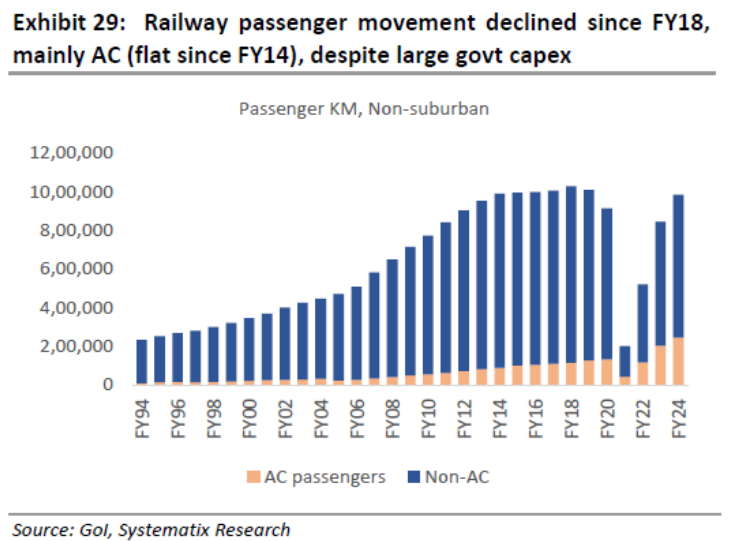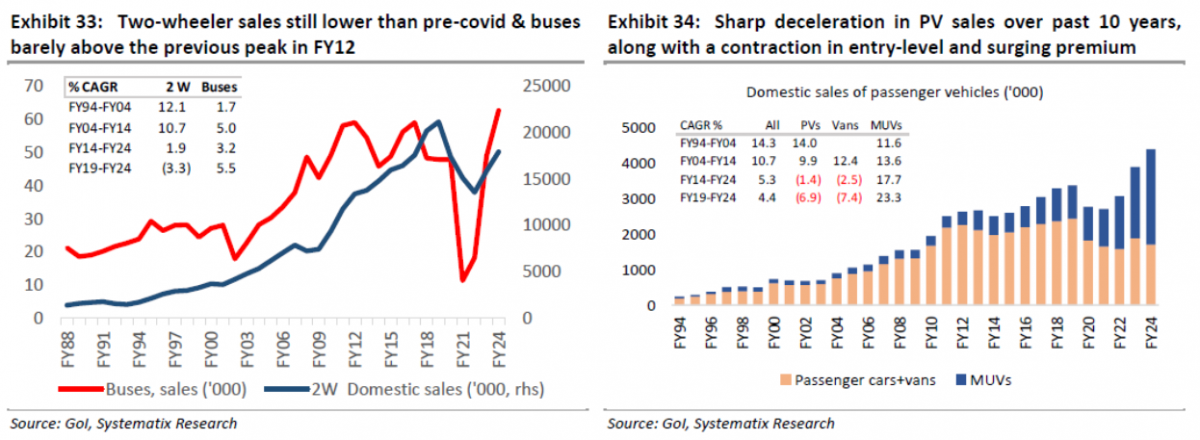Does Household Consumption Data Confirm the Sustenance of Engel’s Law?
The latest Household Consumption Expenditure Survey (HCES 2023), after a gap of 11 years, shows that the proportion of monthly per capita expenditure (MPCE) spent on food has fallen sharply. When compared with the last survey, 46.4% versus 52.9% earlier in rural areas and 39.2% versus 42.6% earlier in urban areas. Taken along with the rising proportion of expenditure on conveyance and other non-food items, the decline in spending on food is seen by many as the progression of Engel’s law and Bennet’s law.
Engel's law suggests that as family income increases, the percentage spent on food decreases, even though the total amount of food expenditure increases. Bennett's law observes that as incomes rise, people eat relatively fewer calorie-dense starchy staple foods and relatively more nutrient-dense meats, oils, sweeteners, fruits, and vegetables.
Put simple, these laws imply that as households experience higher incomes, they gain better access to convenience, with fewer calorie requirements. Thus, the proportion of income spent on food decreases as money spent on other goods or services rises. The summary tables from HCES have convinced many about this observation.
It is well-known that as real incomes rise due to increased economic opportunities, workers from labour-intensive rural areas tend to migrate to urban areas. This phenomenon has been one of the reasons for the structural decline in calorie and cereal consumption since the late 1980s. Therefore, the consumption of basic foods, particularly cereals, is correlated with the quality, or type, of work people engage in.
We test this hypothesis by dissecting item-wise spending shown in the CES.
Over the last 11 years, CES indicates a sharp deceleration in spending on food from 12.2% (two-year CAGR, 2011-12) to 7.9% (46% of MPCE), mainly on cereals, pulses, and sugar, in rural areas. For urban areas, it decelerated from 12.8% (two-year CAGR, 2011-12) to 7.7% in 2022-23 (39% of MPCE).
In the non-food segment, expenditure on conveyance has seen a substantial rise. Components including toilet articles, household consumables, and durables also saw higher growth. On the face of it, these changes in the CES spending pattern indicate a progression typically associated with rising real incomes.
The overall MPCE has during the 11-year period also decelerated: 9.2% for rural at Rs 3,773 and 8.5% for urban at Rs 6,459.
The income test
The first test should be done to see if household incomes have risen.
Derivation of household income from the decelerating private consumption and decline in savings indicate that there has been a sharp deceleration in aggregate real household income growth. It slowed to 3% (four-year CAGR) in FY23, from the peak of 9% in FY10 (based on the 2004-05 GDP series).
According to the Periodic Labour Force Survey (PLFS), which has published data from 2017-18 to 2022-23, the nominal average income for regular, casual, and self-employed workers grew modestly at a rate of 2.2% (five-year CAGR), or -3% in real terms. This contraction in real earnings per worker led to an increase in the number of working persons per household, rising by 3.4%. Consequently, household income saw a mere 5.7% increase, barely keeping pace with the rise in the cost of living.
The PLFS-based estimates – which represent nearly 90% of the working population – do not support the basic condition of the Engel's law.
The second test would be to look at the spending on education and medical expenditure, which should rise with rising income.
The decline in the share of spending on education needs to be closely watched as it could impact long-term labour productivity.
Also read: What Is the Health and Education Cess Being Spent On?
Cereal consumption test
This looks out of sync because of the divergence between spending patterns and inflation rates.
India’s annual cereal production grew by 2.1%. The real spending on bread, cereals, and pulses, as per the Private Final Consumption Expenditure (PFCE, GDP) over the decade has been higher at 3.8%.
If the real consumption, as per the survey, indeed contracted by 2.5% to 3.5%, there would be a situation of oversupply and a crash in prices. More so recently, the supply impulses improved over the last five years due to stepped-up irrigation, higher reservoir capacity, record production, and export ban, along with a significant rundown in the government buffer under the post-COVID free food distribution programme.
In contrast, cereal inflation remained at 5.2% (11-year CAGR) and 6.1% (five-year CAGR). In FY24, it has averaged at 10.9%.
Also read: India’s Inequality at Historic High; Wealth Concentration Shot up Sharpest Between 2014-5 and 2022-3
Affluence test for rising spending on conveyance
Fourth, the proportion of expenditure on conveyance has increased substantially since 2011-12, in both rural (15.2%, 11-year CAGR) and urban areas (11.3%).
However, such a substantial surge in spending does not match with the a) contraction in passenger kilometres travelled in railways in the last 10 years, and b) collective stagnation in the sales of two-wheelers, buses, and passenger cars versus 10 years ago, notwithstanding the post-COVID recovery (see charts below).
Combining these components, representing the conveyance mode for 99% of the population, the average growth is a meagre 0.8%. Hence, the surge in expenditure towards conveyance is because of the higher cost than rising affluence. In particular, the passenger kilometres travelled by railways at 984 billion in FY24 have contracted by 0.5% per annum over the past decade, while the passenger revenue per kilometre surged by 7.7% per annum (see charts below).


Note: Data for exhibit 33 and 34 sourced from CMIE database.
Overall, this deceleration in the consumption in conveyance signifies rising ruralisation, and a declining incentive for the household to move towards the urban areas amid reduced income opportunities. In fact, the PLFS data shows that the population dependent on agriculture (and that lives in rural areas) has risen to 45.8% in 2022-23 from 42.2% in 2017-18.
Tangible evidence of Engels’ law progression missing
Putting together the falling real household income, the aberration in the reported spending on cereals and food from the CES tables, the decline in real per capita usage of conveyance, and rising ruralisation should ideally translate into higher per capita calorie intake, thereby leading to higher cereal consumption. This is paradoxical to Engel’s law of progression.
There appears to be an inadequate representation of the impact of government subsidies, free food distribution, and other dole-outs, in the imputed MPCE, especially in the rural areas. The fiscal support may have created space for spending on non-food items produced by consumer companies. But it is likely to have remained concentrated on basic products. The premiumization story is thus pivoted on the more affluent income earners that lie outside the surveyed universe of the NSSO.
Dhananjay Sinha is co-head of Equities and head of Research of Strategy and Economics at Systematix Group.
This article went live on April ninth, two thousand twenty four, at thirty minutes past five in the evening.The Wire is now on WhatsApp. Follow our channel for sharp analysis and opinions on the latest developments.




